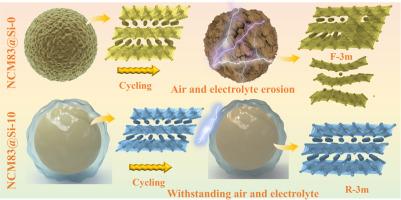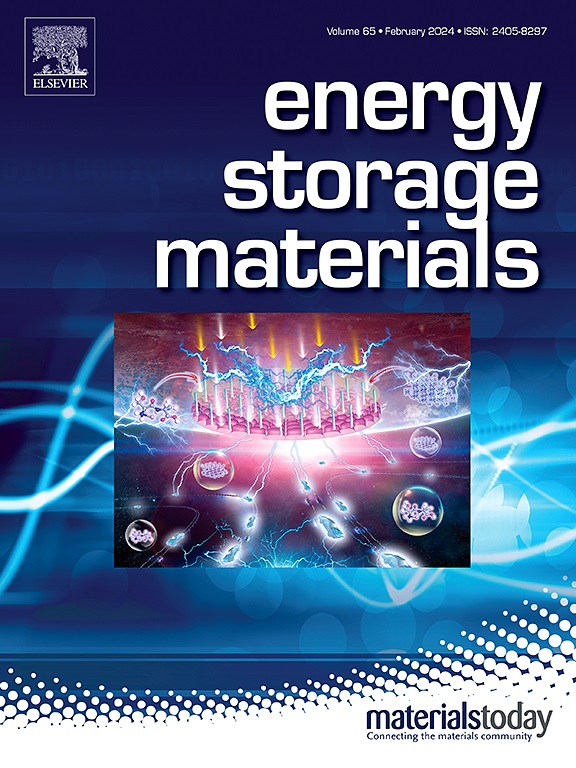Surface stabilization for enhancing air/moisture resistance of layered Ni-rich oxide cathodes
IF 20.2
1区 材料科学
Q1 CHEMISTRY, PHYSICAL
引用次数: 0
Abstract
Layered Ni-rich oxides (LiNixCoyMnzO2, with x ≥ 0.8 and x + y + z = 1) are promising cathode materials for high-energy-density lithium-ion batteries (LIBs) owing to their high specific capacity and high operating voltage. However, the Ni-rich cathode suffers from notorious deterioration when in contact with ambient air, primarily driven by nickel's multivalent (Ni2⁺/Ni3⁺/Ni4⁺) reactions and humidity sensitivity. In this study, we report a novel surface modification strategy for LiNi0.83Co0.12Mn0.05O2 (NCM83) via LixSiOy coating, achieved through chemical grafting using the silane coupling agent, (3-aminopropyl) triethoxysilane (KH550), followed by thermal treatment. The modified NCM83 exhibits enhanced moisture resistance due to a superhydrophobic surface that suppresses detrimental reactions between residual lithium species (Li2O, LiOH, etc.) and water. Furthermore, the LixSiOy coating mitigates mechanical degradation by facilitating strain relaxation. Notably, the modified NCM83 retains high electrochemical performance after 28 days of air exposure, delivering a specific capacity of 157 mAh g⁻1 after 100 cycles at 1C, compared to 108 mAh g⁻1 for the uncoated counterpart. Overall, these findings present an effective strategy for improving upon the surface stability of Ni-rich cathodes, facilitating their processing and paving the way for large-scale applications in high-energy LIBs.


提高层状富镍氧化物阴极抗空气/湿气性能的表面稳定性
层状富镍氧化物(LiNixCoyMnzO2, x≥0.8和x + y + z = 1)具有高比容量和高工作电压的优点,是高能量密度锂离子电池(LIBs)极具发展前景的正极材料。然而,当与环境空气接触时,富镍阴极会出现臭名昭著的劣化,这主要是由镍的多价(Ni2 + /Ni3 + /Ni4 +)反应和湿度敏感性驱动的。在这项研究中,我们报道了一种新的LixSiOy涂层对LiNi0.83Co0.12Mn0.05O2 (NCM83)进行表面改性的策略,该策略是通过硅烷偶联剂(3-氨基丙基)三乙氧基硅烷(KH550)进行化学接枝,然后进行热处理。改性后的NCM83由于其超疏水表面抑制了残余锂(Li2O、LiOH等)与水之间的有害反应,因此具有更强的抗湿性。此外,LixSiOy涂层通过促进应变松弛来减轻机械退化。值得注意的是,经过修饰的NCM83在空气中暴露28天后仍保持着很高的电化学性能,在1C下循环100次后,其比容量为157毫安时(毒血症),而未涂覆的NCM83则为108毫安时(毒血症)。总的来说,这些发现为提高富镍阴极的表面稳定性提供了有效的策略,促进了它们的加工,并为高能锂离子电池的大规模应用铺平了道路。
本文章由计算机程序翻译,如有差异,请以英文原文为准。
求助全文
约1分钟内获得全文
求助全文
来源期刊

Energy Storage Materials
Materials Science-General Materials Science
CiteScore
33.00
自引率
5.90%
发文量
652
审稿时长
27 days
期刊介绍:
Energy Storage Materials is a global interdisciplinary journal dedicated to sharing scientific and technological advancements in materials and devices for advanced energy storage and related energy conversion, such as in metal-O2 batteries. The journal features comprehensive research articles, including full papers and short communications, as well as authoritative feature articles and reviews by leading experts in the field.
Energy Storage Materials covers a wide range of topics, including the synthesis, fabrication, structure, properties, performance, and technological applications of energy storage materials. Additionally, the journal explores strategies, policies, and developments in the field of energy storage materials and devices for sustainable energy.
Published papers are selected based on their scientific and technological significance, their ability to provide valuable new knowledge, and their relevance to the international research community.
 求助内容:
求助内容: 应助结果提醒方式:
应助结果提醒方式:


